Experimental Study on the Contact Force between the Vessel and CBF in the Integrated Floating Transportation Process of Offshore Wind Power †
Abstract
1. Introduction
2. Model Test Setup
3. Results and Interpretation
3.1. Working Condition Arrangement
3.2. Effect of Bow and Stern
3.3. Effect of Wave Height
3.4. Effect of Speed
3.5. Effect of Draft Depth
4. Experimental Results and Practical Engineering Verification
5. Conclusions
- (1)
- In the process of towing, the combination of the vessel and CBF is good. It meets the requirements of towing in long-distance and complex sea conditions. The contact force of the bow facing the wave is much greater than that of the stern. The contact force fluctuation of the bow facing the wave is also much larger than that of the stern.
- (2)
- From the model test results, it can be seen that the three factors have a certain influence on the contact force between the vessel and CBF. The contact force between the vessel and CBF increases with the increase in the towing speed. The contact force between the vessel and CBF increases with the increase in wave height. The contact force between the vessel and the CBF decreases as the draft increases. Increasing the draft is conducive to the safety of wet towing. The influence of towing speed is mainly reflected in the towing resistance. The wave height will directly affect the contact force between the vessel and CBF. Therefore, if there are big waves and adverse environment, it is necessary to avoid navigation or take adequate preventive measures.
- (3)
- According to the experimental results, combined with the appropriate safety factor, setting 500 t pretension can ensure that the vessel and CBF will not disengage during the towing process when applied to practical engineering.
Author Contributions
Funding
Conflicts of Interest
References
- Energy, D.O.N.G. Suction Bucket Jacket Foundation Installed at Borkum Riffgrund 1 (Gallery). 2014. Available online: https://www.offshorewind.biz/2014/08/28/suction-bucket-jacket-foundation-installed-at-borkum-riffgrund-1-gallery/ (accessed on 15 March 2021).
- Esteyco. Elisa—Elican Project, World´s First Cranesless Bottom-Fixed Offshore Turbine. 5MW “Elisa” Prototype. Available online: https://www.esteyco.com/proyectos/elisa-elican-project/ (accessed on 5 June 2021).
- Lee, G.; Kwag, D.; Kim, S.R. Seismic Response Comparison of Offshore Wind Turbines as Types of Support Structures. J. Wind Energy 2019, 10, 5–13. [Google Scholar] [CrossRef]
- Smart, G.; Smith, A.; Warner, E.; Sperstad, I.B.; Prinsen, B.; Lacal-Arantegui, R. IEA Wind Task 26: Offshore Wind Farm Baseline Documentation; National Renewable Energy Lab.: Golden, CO, USA, 2016. [Google Scholar] [CrossRef]
- Lacal-Arántegui, R.; Yusta, J.M.; Domínguez-Navarro, J.A. Offshore wind installation: Analysing the evidence behind improvements in installation time. Renew. Sustain. Energy Rev. 2018, 92, 133–145. [Google Scholar] [CrossRef]
- Guo, Y.; Wang, H.; Lian, J. Review of integrated installation technologies for offshore wind turbines: Current progress and future development trends. Energy Convers. Manag. 2022, 255, 115319. [Google Scholar] [CrossRef]
- Wang, X.; Zeng, X.; Li, J. A review on recent advancements of substructures for offshore wind tur-bines. Energy Convers. Manag. 2018, 158, 103–119. [Google Scholar] [CrossRef]
- Saidur, R.; Islam, M.; Rahim, N.; Solangi, K. A review on global wind energy policy. Renew. Sustain. Energy Rev. 2010, 14, 1744–1762. [Google Scholar] [CrossRef]
- Manwell, J.; Rogers, A.; McGowan, J.; Bailey, B. An offshore wind resource assessment study for New England. Renew. Energy 2002, 27, 175–187. [Google Scholar] [CrossRef]
- Kaldellis, J.; Kapsali, M. Shifting towards offshore wind energy-recent activity and future development. Energy Policy 2013, 53, 136–148. [Google Scholar] [CrossRef]
- Kaldellis, J.; Apostolou, D.; Kapsali, M.; Kondili, E. Environmental and social footprint of offshore wind energy. Comparison with onshore counterpart. Renew. Energy 2016, 92, 543–556. [Google Scholar] [CrossRef]
- Cheng, M.; Zhu, Y. The state of the art of wind energy conversion systems and technologies: A review. Energy Convers. Manag. 2014, 88, 332–347. [Google Scholar] [CrossRef]
- Sarker, B.R.; Ibn Faiz, T. Minimizing transportation and installation costs for turbines in offshore wind farms. Renew. Energy 2017, 101, 667–679. [Google Scholar] [CrossRef]
- Jiang, Z. Installation of offshore wind turbines: A technical review. Renew. Sustain. Energy Rev. 2021, 139, 110576. [Google Scholar] [CrossRef]
- Si, Y.; Chen, Z.; Zeng, W.; Sun, J.; Zhang, D.; Ma, X.; Qian, P. The influence of power-take-off control on the dynamic response and power output of combined semi-submersible floating wind turbine and point-absorber wave energy converters. Ocean Eng. 2021, 227, 108835. [Google Scholar] [CrossRef]
- Achmus, M.; Schroeder, C. Installation and bearing behaviour of bucket foundations for offshore structures. Bautechnik 2014, 91, 597–608. [Google Scholar] [CrossRef]
- Penner, N.; Grießmann, T.; Rolfes, R. Monitoring of suction bucket jackets for offshore wind turbines: Dynamic load bearing behaviour and modelling. Mar. Struct. 2020, 72, 102745. [Google Scholar] [CrossRef]
- Plodpradit, P.; Kwon, O.; Dinh, V.N.; Murphy, J.; Kim, K.-D. Suction Bucket Pile–Soil–Structure Interactions of Offshore Wind Turbine Jacket Foundations Using Coupled Dynamic Analysis. J. Mar. Sci. Eng. 2020, 8, 416. [Google Scholar] [CrossRef]
- Liu, R.; Ma, W.-G.; Qi, Y.; Wu, X.-L. Experimental studies on the drag reduction effect of bucket foundation installation under suction pressure in sand. Ships Offshore Struct. 2019, 14, 421–431. [Google Scholar] [CrossRef]
- Spain: Elisa Turbine Fully Installed, Awaiting Grid Connection. 2021. Available online: https://www.offshorewind.biz/2018/07/04/spain-elisa-turbine-fully-installed-awaiting-grid-connection/ (accessed on 22 June 2021).
- SPT Offshore. AOWF Suction Bucket Tests Jackets. 2016. Available online: https://www.sptoffshore.com/projects/aowf-suction-bucket-tests-jackets-with-suction-pile-foundations/ (accessed on 21 March 2021).
- Dong, X.; Lian, J.; Wang, H.; Yu, T.; Zhao, Y. Structural vibration monitoring and operational modal analysis of offshore wind turbine structure. Ocean Eng. 2018, 150, 280–297. [Google Scholar] [CrossRef]
- Borg, M.; Shires, A.; Collu, M. Offshore floating vertical axis wind turbines, dynamics modelling state of the art. Part I: Aerodynamics. Renew. Sustain. Energy Rev. 2014, 39, 1214–1225. [Google Scholar] [CrossRef]
- Zhang, P.; Ding, H.; Le, C. Model tests on tilt adjustment techniques for a mooring dolphin platform with three suction caisson foundations in clay. Ocean Eng. 2013, 73, 96–105. [Google Scholar] [CrossRef]
- Ding, H.; Lian, J.; Li, A.; Zhang, P. One-step-installation of offshore wind turbine on large-scale bucket-top-bearing bucket foundation. Trans. Tianjin Univ. 2013, 19, 188–194. [Google Scholar] [CrossRef]
- Zhang, P.; Han, Y.; Ding, H.; Zhang, S. Field experiments on wet tows of an integrated transportation and installation vessel with two bucket foundations for offshore wind turbines. Ocean Eng. 2015, 108, 769–777. [Google Scholar] [CrossRef]
- Zhang, P.; Ding, H.; Le, C. Hydrodynamic motion of a large prestressed concrete bucket foundation for offshore wind turbines. J. Renew. Sustain. Energy 2013, 5, 63126. [Google Scholar] [CrossRef]
- Ding, H.; Zhao, X.; Le, C.; Zhang, P.; Min, Q. Towing Motion Characteristics of Composite Bucket Foundation for Offshore Wind Turbines. Energies 2019, 12, 3767. [Google Scholar] [CrossRef]
- Ding, H.; Feng, Z.; Zhang, P.; Le, C.; Guo, Y. Floating Performance of a Composite Bucket Foundation with an Offshore Wind Tower during Transportation. Energies 2020, 13, 882. [Google Scholar] [CrossRef]
- Cardoso, J.; Vieira, M.; Henriques, E.; Reis, L. Computational analysis of the transportation phase of an innovative foundation for offshore wind turbine. Ships Offshore Struct. 2020, 16, 725–734. [Google Scholar] [CrossRef]
- Lian, J.; Jiang, J.; Dong, X.; Wang, H.; Zhou, H. One damping estimation approach of the parked offshore wind turbine supported by wide-shallow bucket foundation. Ocean Eng. 2021, 235, 109387. [Google Scholar] [CrossRef]
- Lian, J.; Wang, P.; Wang, H.; Guo, Y.; Xu, Y.; Ye, F.; Yang, Y. Experimental study of one-step overall transportation of composite bucket foundation for offshore wind turbine under the coupled dynamic action of wave and current. J. Renew. Sustain. Energy 2021, 13, 035701. [Google Scholar] [CrossRef]
- Castro-Santos, L.; Vizoso, A.F.; Lamas-Galdo, I.; Couce, L.C. Methodology to calculate the installation costs of offshore wind farms located in deep waters. J. Clean. Prod. 2018, 170, 1124–1135. [Google Scholar] [CrossRef]
- Zhang, P.; Ding, H.; Le, C. Motion analysis on integrated transportation technique for off-shore wind turbines. J. Renew. Sustain. Energy 2013, 9, 053117. [Google Scholar] [CrossRef]
- Ding, H.; Han, Y.; Le, C.; Zhang, P. Dynamic analysis of a floating wind turbine in wet tows based on multi-body dynamics. J. Renew. Sustain. Energy 2017, 9, 03301. [Google Scholar] [CrossRef]




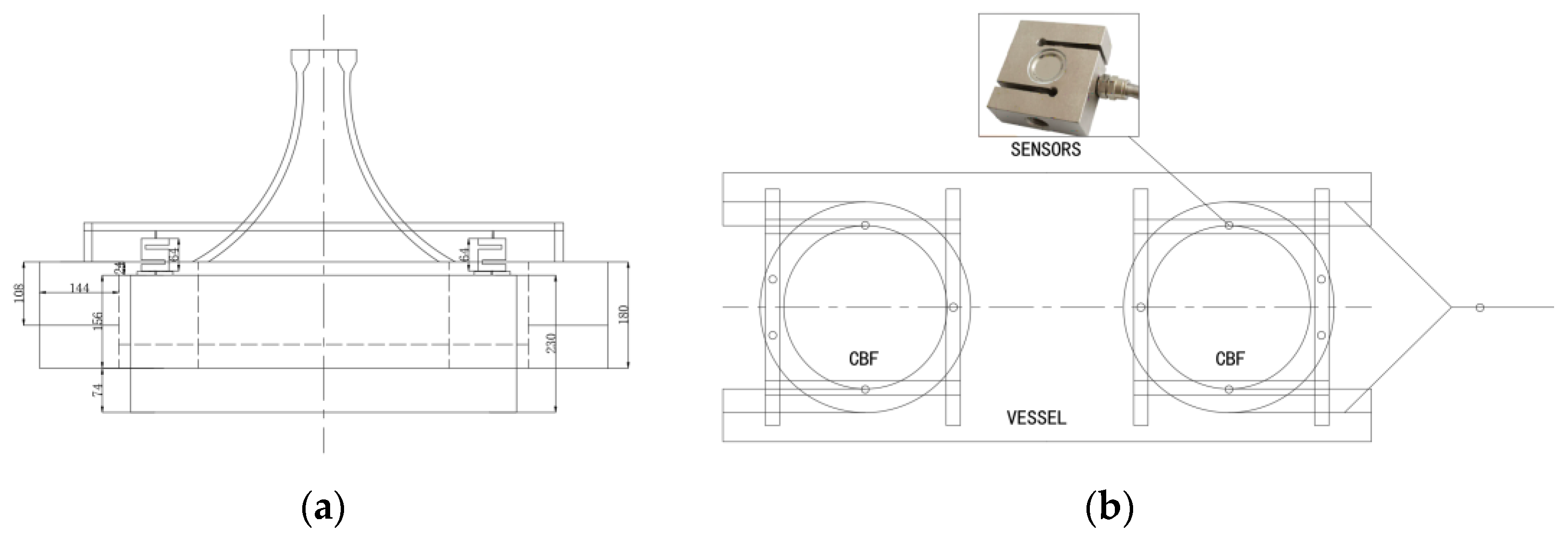
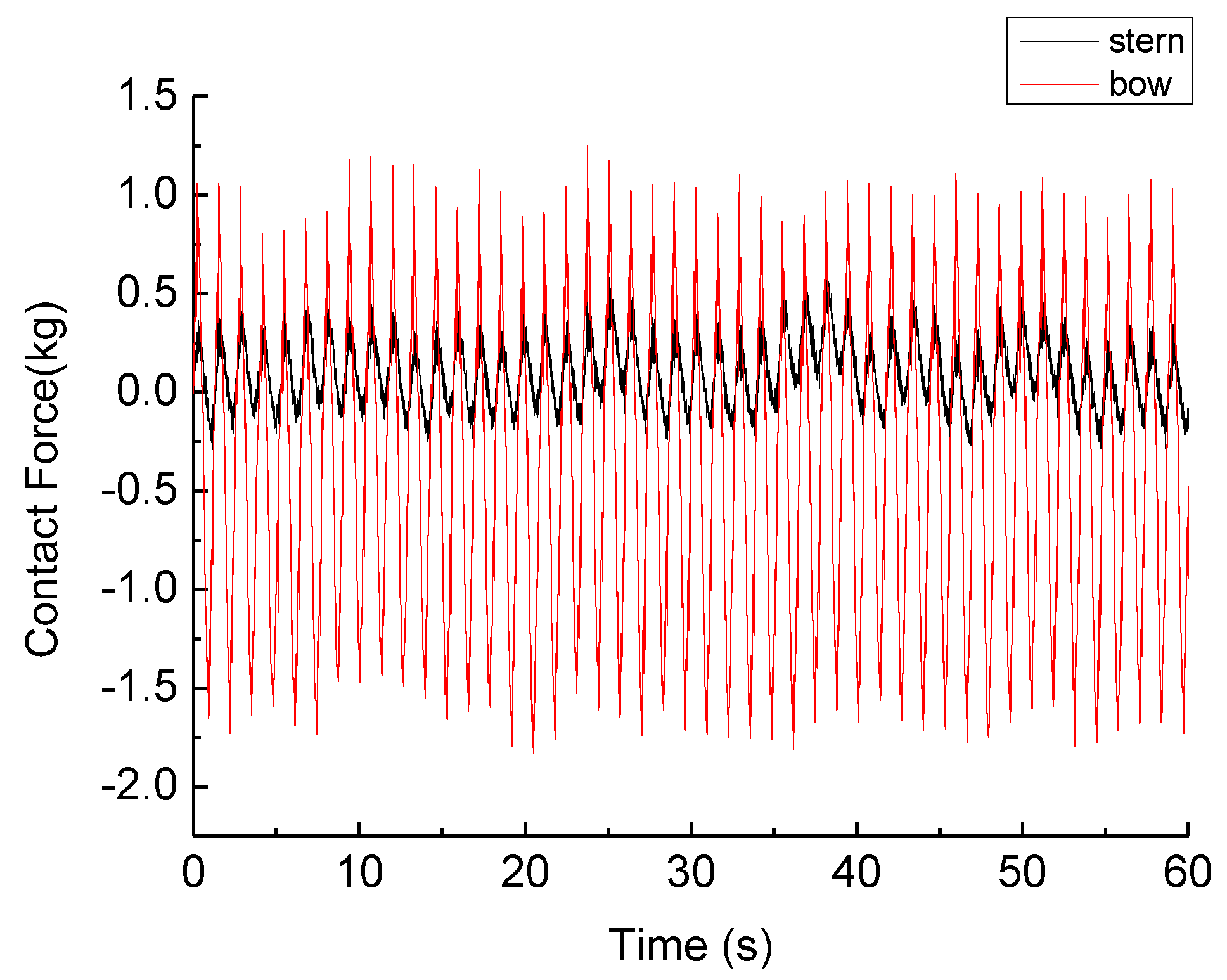
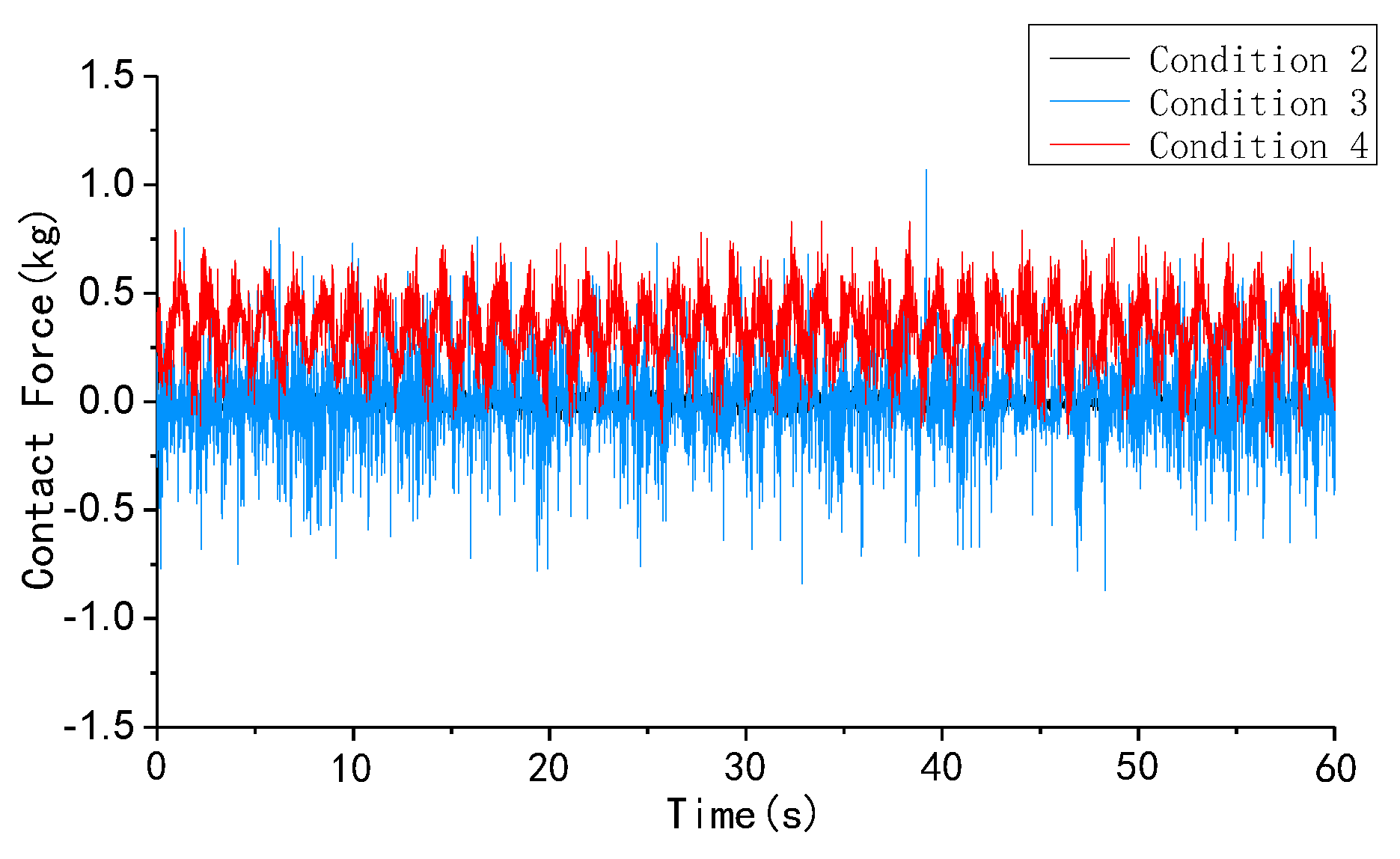
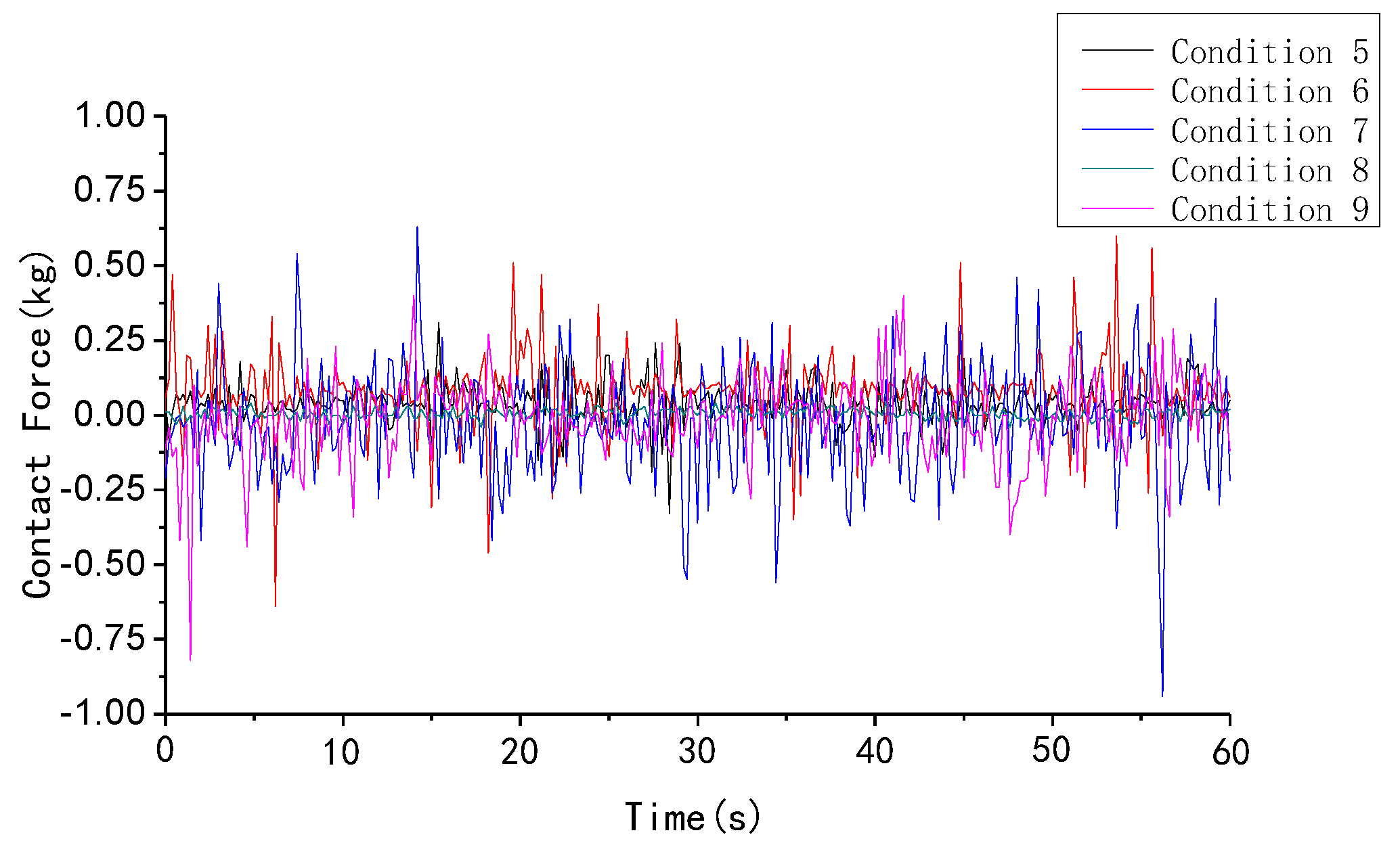
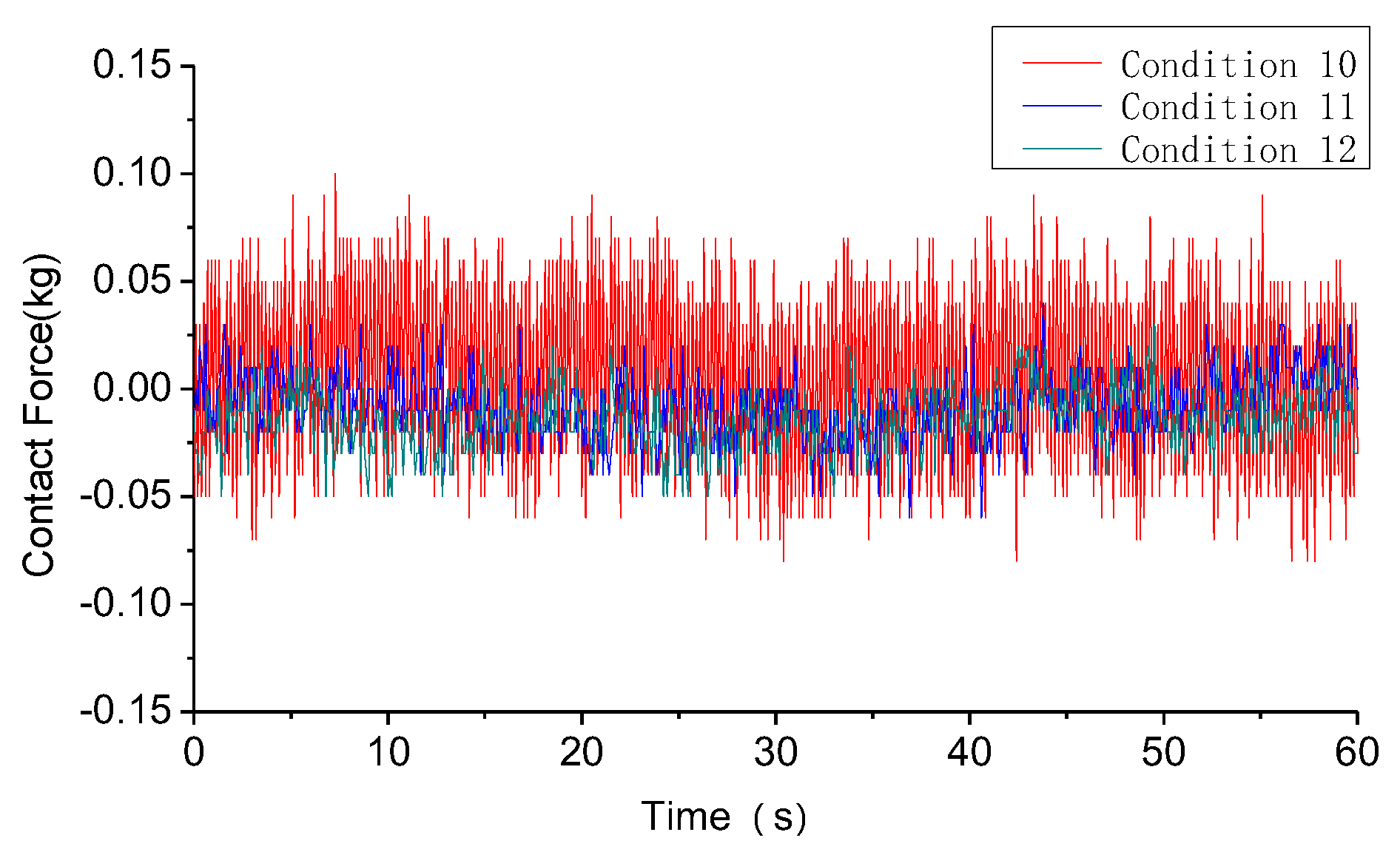

| Full Scale | Model Scale | |
|---|---|---|
| Length (m) | 103.2 | 2.064 |
| Width (m) | 51.6 | 1.032 |
| Depth (m) | 9 | 0.18 |
| Draft of vessel (m) | 6 | 0.12 |
| Displacement (t) | 16,700 | 0.1336 |
| Bottom area (m2) | 2783 | 1.11 |
| Full Scale | Model Scale | |
|---|---|---|
| Diameter (m) | 35 | 0.7 |
| Depth (m) | 11.5 | 0.23 |
| Weight (kg) | 3807 × 103 | 30.5 |
| Bottom area (m2) | 962 | 0.385 |
| Items | Units | Parameter 1 | Parameter 2 | Parameter 3 | Parameter 4 | Parameter 5 |
|---|---|---|---|---|---|---|
| Wave height H (period) | m | 0 | 0.03 (0.86) | 0.05 (1.06) | ||
| Towing speed V | m/s | 0.22 | 0.29 | 0.36 | 0.43 | 0.50 |
| Draft depth h1 | m | 0.12 | 0.10 | 0.08 |
| Items | Units | Condition 1 |
|---|---|---|
| Wave height H H (period) | m | 0.05 (1.06) |
| Towing speed V | m/s | 0.43 |
| Draft depth h1 | m | 0.12 |
| Items | Units | Condition 2 | Condition 3 | Condition 4 |
|---|---|---|---|---|
| Wave height H H (period) | m | 0 | 0.03 (0.86) | 0.05 (1.06) |
| Towing speed V | m/s | 0.36 | 0.36 | 0.36 |
| Draft depth h1 | m | 0.12 | 0.12 | 0.12 |
| Items | Units | Condition 5 | Condition 6 | Condition 7 | Condition 8 | Condition 9 |
|---|---|---|---|---|---|---|
| Wave height H H (period) | m | 0.03 (0.86) | 0.03 (0.86) | 0.03 (0.86) | 0.03 (0.86) | 0.03 (0.86) |
| Towing speed V | m/s | 0.22 | 0.29 | 0.36 | 0.43 | 0.50 |
| Draft depth h1 | m | 0.12 | 0.12 | 0.12 | 0.12 | 0.12 |
| Items | Units | Condition 10 | Condition 11 | Condition 12 |
|---|---|---|---|---|
| Wave height H | m | 0.03 | 0.03 | 0.03 |
| Towing speed V | m/s | 0.36 | 0.36 | 0.36 |
| Draft depth h1 | m | 0.08 | 0.10 | 0.12 |
Publisher’s Note: MDPI stays neutral with regard to jurisdictional claims in published maps and institutional affiliations. |
© 2022 by the authors. Licensee MDPI, Basel, Switzerland. This article is an open access article distributed under the terms and conditions of the Creative Commons Attribution (CC BY) license (https://creativecommons.org/licenses/by/4.0/).
Share and Cite
Meng, L.; Ding, H. Experimental Study on the Contact Force between the Vessel and CBF in the Integrated Floating Transportation Process of Offshore Wind Power. Energies 2022, 15, 7970. https://doi.org/10.3390/en15217970
Meng L, Ding H. Experimental Study on the Contact Force between the Vessel and CBF in the Integrated Floating Transportation Process of Offshore Wind Power. Energies. 2022; 15(21):7970. https://doi.org/10.3390/en15217970
Chicago/Turabian StyleMeng, Lingqian, and Hongyan Ding. 2022. "Experimental Study on the Contact Force between the Vessel and CBF in the Integrated Floating Transportation Process of Offshore Wind Power" Energies 15, no. 21: 7970. https://doi.org/10.3390/en15217970
APA StyleMeng, L., & Ding, H. (2022). Experimental Study on the Contact Force between the Vessel and CBF in the Integrated Floating Transportation Process of Offshore Wind Power. Energies, 15(21), 7970. https://doi.org/10.3390/en15217970





